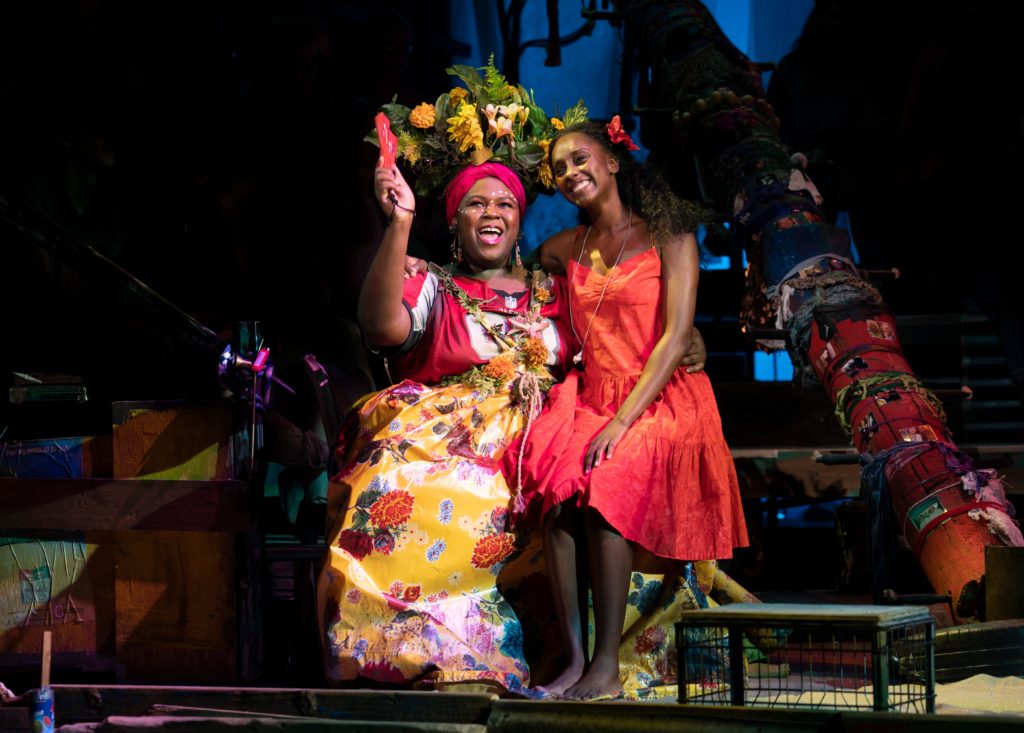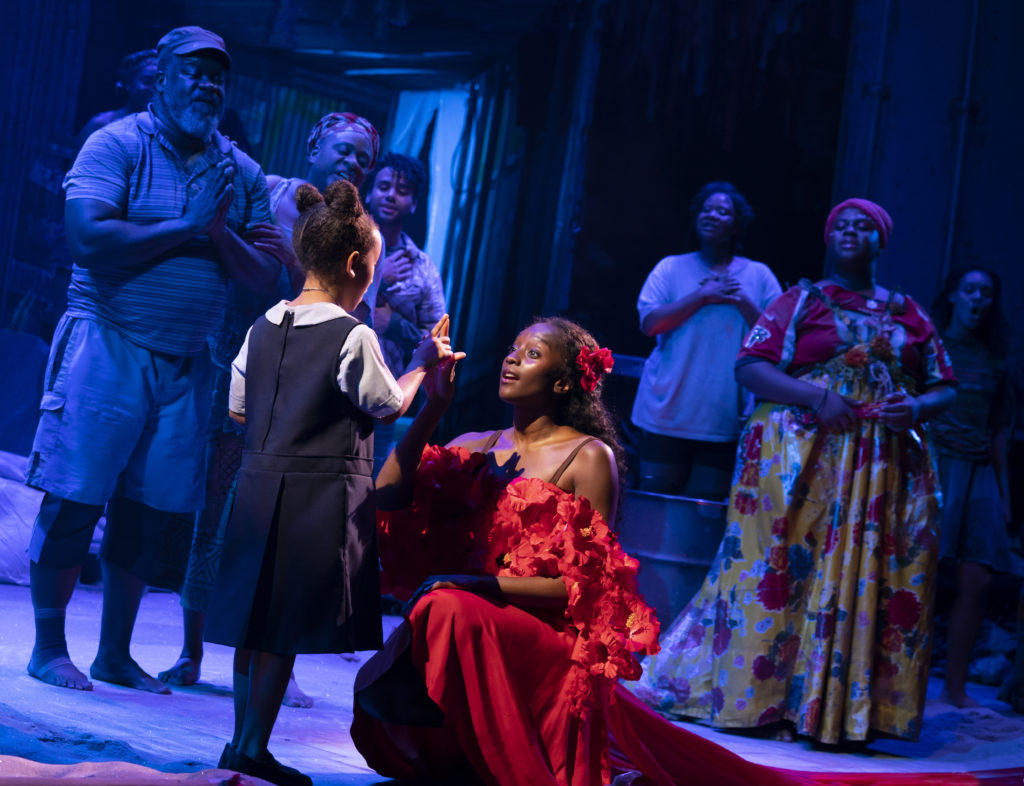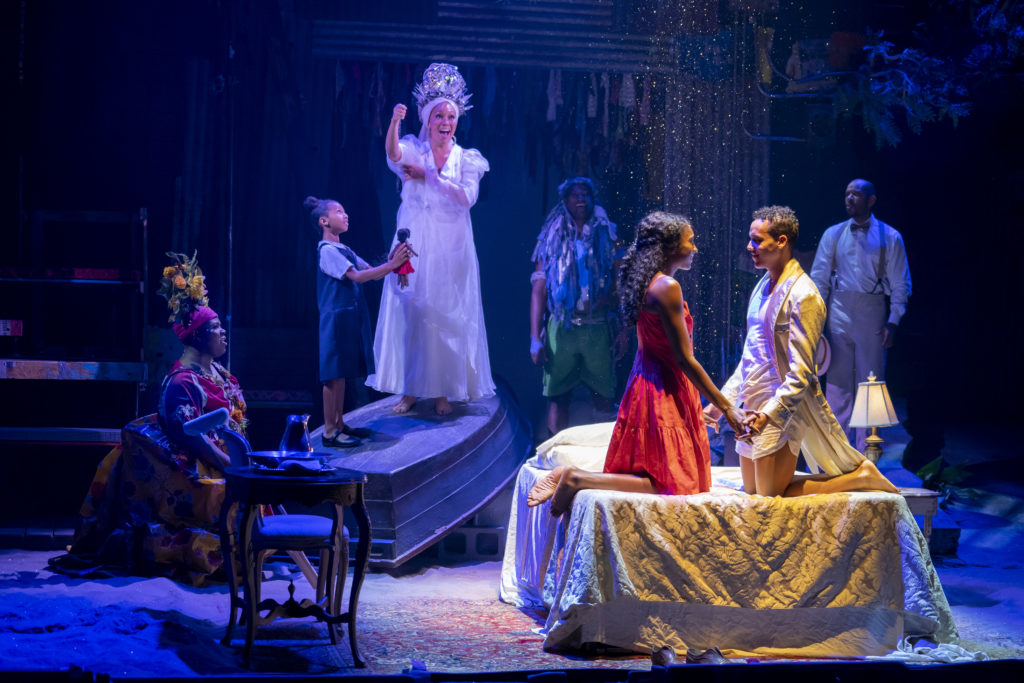
Kyle Ramar Freeman as ‘Asaka’ and Courtnee Carter as ‘Ti Moune’ in the North American Tour of “Once on This Island”. All photo by Joan Marcus
Earlier this week Music City finally began the transition from an unusually long, hot summer to the much-awaited chill of autumn, with even a promise of rain. As if designed by the gods themselves, those elements also seem to be present inside TPAC’s Jackson Hall as Nashville plays host to the premiere performances of the first-ever National Tour of Broadway’s Once on this Island.
Initially taking Broadway by storm (pun fully intended) when it debuted in 1990, Once on This Island tells the tropical island tale of a young girl who sacrifices her very soul to save the life of the boy she feels it is her destiny to meet, protect and love. Based on Rosa Guys’ 1985 novel, My Love, My Love: Or, The Peasant Girl, the story itself is a modern retelling of Hans Christian Andersen’s The Little Mermaid. That said, if you’re expecting a happy-go-lucky mermaid flippin’ her fin with Flounder and friends, you’re thinking the wrong mermaid tale, for Guys’ novel and this theatrical interpretation, in particular, share more in common with the original fairytale than that of the House of Mouse.
Instead, Once on This Island delivers a thought-provoking look at love, lust, dreams, faith and magic while skillfully simultaneously examining the realities of racism, classism and even colorism on a remote Caribbean Island.
Even before the action of the play actually begins, theatre patrons who arrive early are immediately swept away to a tropical oasis. Rather than a lowered curtain obscuring the stage, Once on This Island invites the audience to preview what’s to come by having the set in full view upon entry to the theatre. As cast members buzz about on stage, it seems evident all is not postcard-perfect on the island. Instead, we see islanders picking through trash strewn along the sand—yes, the stage is covered in a fine layer of sand, just one of the actual natural elements that play such a large part in the play. It soon becomes clear that we are witness to the aftermath of a tropical storm, perhaps also a bit of foreshadowing of the eye of the storm at the heart of the piece.
Further immersing the audience into the mix, a handful of lucky patrons find their seats amongst chairs and risers on the stage itself. This particular aspect of the tour is done to attempt to replicate the show’s recent Broadway revival at Circle in the Square, one of only two Broadway theatres that utilizes a stage that is surrounded on three sides by audience seating.
Directed by Tony-nominated Michael Arden (Spring Awakening), with book and lyrics by Lynn Ahrens and music by Stephen Flaherty (Original Score Tony-winners for Ragtime), with Dane Laffrey’s authentic set design, costumer Clint Ramos’ inventive and colorful wardrobe and a company of accomplished and talented actors, Once on This Island presents a storm-wrecked island complete with ramshackle dwellings, displaced belongings and all, but also present, an obviously tight-knit community, a community of survivors. A community of love and hope for rebuilding the future and surviving the next storm. Heck, in the opening number We Dance reinforces the islander’s optimism when, as they pick through the wreckage, they proudly sing, “We are dancing just to stay alive”.

As the story begins, locals find a young girl alone and frightened the morning after a storm. Young actors Mimi Crossland and Mariama Diop share the role of the Little Girl, alternating performances. On opening night Crossland was seen in the role and she was delightfully charming.
With perhaps a wink to the Hans Cristian Andersen original mermaid lore, the young girl is initially thought to be unable to speak, but that proves to be a falsity as she gleefully joins the islanders as they tell her the tale of Ti Moune, a beautiful dark-skinned orphan girl raised by a poor but loving couple, Tonton Julian (Tony winner, Phillip Boykin) and Mama Euralie (Danielle Lee Greaves). These two present their characters with a lovely balance of guidance and understanding and immeasurable vocal skills, setting the pace for the entire show with powerful, emotional performances.
As the storytellers tell the Little Girl the story, the action transitions to a grown up Ti Moune (Courtnee Carter) as she rescues Daniel Beauhomme(Tyler Hardwick)…and yes, the character’s last name literally translates from the French as ‘beautiful man. Ti Moune meets Daniel, a light-skinned wealthy young man of both French and Caribbean descent who crashes his car on the “wrong side of the island”. Feeling it’s her true destiny, she leaves her family to journey to the other side of the island to return him to his home and nurse him back to health. Some time later, he lapses into a coma and here’s where the story veers a bit from the mermaid source material. Instead of our heroine making a deal with a sea witch in exchange for her beautiful voice, Ti Moune makes a deal with Papa Ge, the Demon God of death (played by former American Idol favorite, Tamyra Gray) to trade her life for her beloved’s. That plot twist, and its subsequent effects bring a bit of Romeo and Juliet vibe to the piece.
Gray’s Papa Ge isn’t the only god involved in the story. There’s also Erzulie, the Goddess of Love, played by Cassondra James; Jahmaul Bakare’s Agwe, the God of Water and Asaka, Mother Earth as presented by Kyle Ramar Freeman. As their character names and casting might infer, Gods, Goddesses and Demons aren’t restrained by antiquated ideals of gender norms, but rather representational of a fluidity mere mortals are finally just beginning to understand. Case in point, when the original production of Once on This Island debuted on Broadway in 1990, Papa Ge was played by a male actor. Since it’s revival, the role has been played by female actors. Meanwhile, the reverse is true for Asaka. Initially the role was portrayed by a female, but since the revival, it’s been less gender specific. Just another lesson to be learned during your visit on the island.
While the story itself is often-times familiar, both in the Little Mermaid sense, and the age-old young girl sacrificing everything for a man sense, it’s the vibrancy of the music, paired with Camille A. Brown’s energetic and emotional choreography and the powerhouse performances of the entire cast that, much like the gods who are represented, breath fire, life and air into the piece.
Carter is blissfully perfect as Ti Moune. With a voice fitting the oft-referenced mermaid, regardless of your views of perpetuated stereotype of the woman sacrificing all for the man she loves, Carter’s performance is excellently layered and heartfelt. The highpoint of her performance, and dare I say, the entire play, Ti Moune’s Dance, during which she boldly arrives to a proper cotillion dressed in a flowing island dress in her character’s signature red and performs an unabashedly passionate dance of her native culture, at once shocking and enthralling her more refined critics and onlookers, who by no coincidence of the show’s costumer, are dressed in regal, yet blandly off-white finery. I can’t be the only one who was reminded of Bette Davis’ red dress moment in the classic film Jezebel during this breathtaking scene.

The Gods of Once on This Island also shine in their individual ways. Gray presents Papa Ge with a strength and presences to be reckoned with. Powerful yet perfectly sinister, her rich vocals are the stuff of which fear is made. Shoot, even her costume is partially fashioned from what appears to be caution tape, a literal warning of things to come. Bakare, aided by a Triton-esque beard fashioned from shredded fabric portrays the gentleness of the water with an ever-present ability to literally turn the tide at any moment. James’ Erzulie, complete in a flowing gown and royal headpiece, is majestic and beautiful with a voice to match. Freeman, who somehow reminds me of a gentler Evilene from The Wiz, portrays a loving Earth Mother with flair and feistiness. Gotta love a Goddess who can make a gown out of a discarded floral tablecloth.
Credit where credit is due, t’s the midway showstopper Mama Will Provide and Ti Moune’s aforementioned dance that will linger in the audience’s mind long after the sands of time have washed away the rest of Once on This Island.
While the show doesn’t exactly offer a traditional Happy Ending, the playwrights do offer up a simply divine finale as the entire ensemble of Once on this Islandsings the joyous finale Why We Tell the Story. It’s the perfect spirit-rejuvenating number that, in spite of the less-than storybook ending, allows the audience to leave the audience with the rhythm of the island in their bodies and the positivity of love and faith on their minds.
Once on This Island wraps its opening week at TPAC’s Jackson Hall as performances continue through the weekend with an evening performance Friday October 18, as well as matinee and evening performances Saturday and Sunday, October 19 & 20 before heading out on the road as this debut National Tour continues. CLICK HERE for tickets to this week’s remaining Nashville performances.
Following their Music City dates, Once on This Island continues their National Tour with upcoming dates across the US through June 2020. CLICK HERE to see when the show is coming to a theatre near you or follow Once on This Island on Facebook, Instagram, YouTube and Twitter.
TPAC’s 2019/2020 Broadway Season continues with The SpongeBob Musical November 5-10, CATS November 19-24, Hamilton December 31-January 19, My Fair Lady February 4-9, Blue Man Group February 11-16, Jesus Christ Superstar March 3-8, The Color Purple March 27-29, Escape to Margaritaville May 5-10m Summer: The Donna Summer Musical May 26-31 and Charlie and the Chocolate Factory June 9-14. CLICK HERE for more.
To keep up with what’s happening at TPAC, follow them on Facebook, Twitter and Instagram as well.
As always, if you are interested in coverage for your latest entertaining endeavor, simply click the contact page and drop me a note. You can also follow JHP Entertainment on Instagram and Facebook.